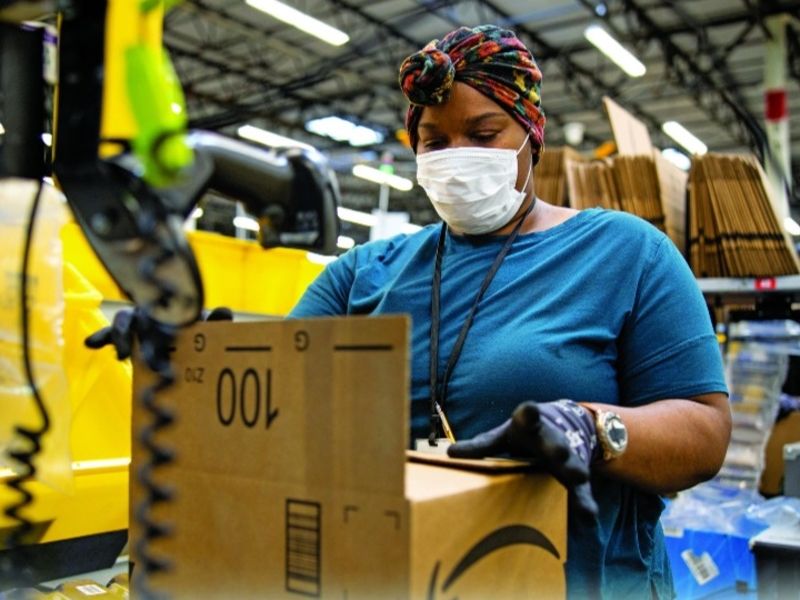
As if it hasn’t been hard enough recruiting work forces over the past couple of years, with booming sales and low unemployment, before the coronavirus pandemic.
Now, as business slowly creeps back to normal, automotive companies face a new challenge: Amazon.
The online marketplace plans to recruit 100,000 hourly U.S. and Canadian workers at a starting wage of $15. That is about 20 percent more than auto parts plants typically pay to start.
It’s making auto-sector expansion a bit tougher than normal.
“Not just Amazon, but all of the employers who have done well through the pandemic while the auto industry was stalled,” said Dietmar Ostermann, U.S. automotive advisory leader for PwC, “like Home Depot, food companies, grocery chains and medical-sector companies.”
Automotive manufacturers are increasingly competing for hourly labor with these major corporations and large gig economy employers — just one of many factors in the auto industry’s struggle to expand production.
To compete with other business segments, automotive employers are getting creative and reevaluating how they procure talent. That includes dispensing with some of the traditional hiring contingencies, such as drug testing and background screening, says Keilon Ratliff, vice president and automotive lead at Kelly Professional & Industrial.
“You now have different sectors all looking for the same talent, and people are amending some of the qualifications that they have on the front end,” he said. “Companies have had to adjust those processes in order to compete.”
Auto manufacturers have been dealing with some of the lowest unemployment rates in the U.S. since World War II. Trying to recruit workers in a market in which there is little available labor has been difficult.
This year, even though thousands of American workers were laid off and coping with a recession, the task of recruiting factory workers has been exacerbated by COVID-19. People are hesitant to take a job in a factory. And the availability of unemployment benefits of up to $25 an hour is beating out the lure of lower wages to go work in the potentially dangerous close quarters of an assembly plant.
Now it’s all now coming to a head.
“There is a significant shortage of workers in the auto industry right now,” Ostermann said.
As employers try to get new hiring projects on track, or just return to previous production levels, the shortage of workers is a bottleneck. Missing just a tenth of a needed work force can hold back volumes or thwart efforts to operate a plant efficiently.
David Kalb, president at Applied Tech Industries, a Tier 2 specialized automotive coatings provider in Chesterfield, Mich., said he has not been able to find enough workers to keep up with production commitments shortly after the industry came back on line.
“We had to go to 10-hour shifts, six days a week because we couldn’t get good help, other than the people we had,” said Kalb, who services 12 auto assembly plants.
In addition to working additional hours, Kalb had to outsource some work to competitors. “Just in trying to find people, we’ve added more temp agencies,” he said. “We had to increase our pay by a couple of bucks an hour, because that’s what the market was doing at the time.”
Others have asked salaried engineers to fill gaps on assembly lines.
“There’s definitely a battle for talent,” Ratliff said. “Customers are experiencing higher turnover rates. As we’re looking to engage with the work force, there’s lower enthusiasm to go back to work due to COVID.
“The war for talent became that much more challenging.”
Some employers also are considering making their wages more competitive, and partnering with organizations that have a pipeline to the manufacturing work force.
The Texas Workforce Commission — a state agency that provides work force development services to support the state’s economic development activities — creates grant programs that aim to boost the available worker pool. The commission connects incoming or expanding companies with those workers.
Texas is awaiting the arrival of a new Tesla Gigafactory truck plant southeast of Austin, which is likely to pull in more suppliers and spur local parts companies to expand production. That will create the need for more auto workers around Austin — an area that is hardly hurting for jobs. In addition to the University of Texas and state government offices, Dell Technologies is a major local employer, and a new Apple campus there plans to hire 15,000 people.
“You can have all the great tax incentives and benefits and be a nonunion state and all these things that Texas has, but if you don’t have the work force that is ready to meet those needs, that’s going to hurt that recruitment,” said James Bernsen, deputy director of communications at the state commission. “A key input is having that work force, and that’s really been our strength.”